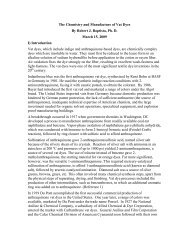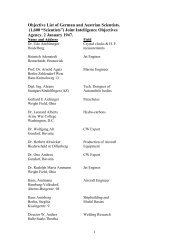International Dyestuff Industry - ColorantsHistory.Org
International Dyestuff Industry - ColorantsHistory.Org
International Dyestuff Industry - ColorantsHistory.Org
You also want an ePaper? Increase the reach of your titles
YUMPU automatically turns print PDFs into web optimized ePapers that Google loves.
Greenford Green Works, 1858. Edelstein Collection, Hebrew<br />
University.<br />
Unfortunately, the product proved difficult to sell, except for the limited application of<br />
dyeing silk, because of the difficulties of attachment to cotton. Consequently, there was<br />
little enthusiasm from the calico printers in Lancashire and Scotland.<br />
Nevertheless, purple had become the leading color of fashion in Paris and London, probably<br />
because of the introduction of a fast and brilliant lichen dye, French purple, manufactured<br />
by a firm in Lyon. Perkin was under pressure to develop a suitable mordant for cotton,<br />
which he achieved at the same time as Robert Pullar. Then the product had to be sold to<br />
the printers, which required considerable travel throughout Britain and trials in the factories<br />
of potential consumers. These succeeded, and the synthetic color, at first named Tyrian<br />
Purple, after the fabled Levantine dye, became a success early in 1859. [13]<br />
Perkin at age 22 (1860). Edelstein Collection, Hebrew University.<br />
The production of the new color required plentiful supplies of aniline, made in two<br />
steps—nitration and reduction—from benzene, which was distilled from coal tar. At first the<br />
process apparatus was made of glass, but when demand picked up the Perkins introduced<br />
small hand stirred iron equipment. These reactors were scaled up, and mechanized, by<br />
Edward Chambers Nicholson of the South London chemical manufacturer Simpson, Maule &<br />
Nicholson; the partners were also former students of Hofmann. Perkin would not license his<br />
patented process to other firms in Britain, which meant that new progress was made<br />
elsewhere. Lyon dyers, who specialized in silks, were soon experimenting with the aniline<br />
reaction. They and innovative Parisian firms, such as Depoully and Castelhaz, manufactured<br />
aniline purple on a considerable scale from the end of 1858, as did one or two German





